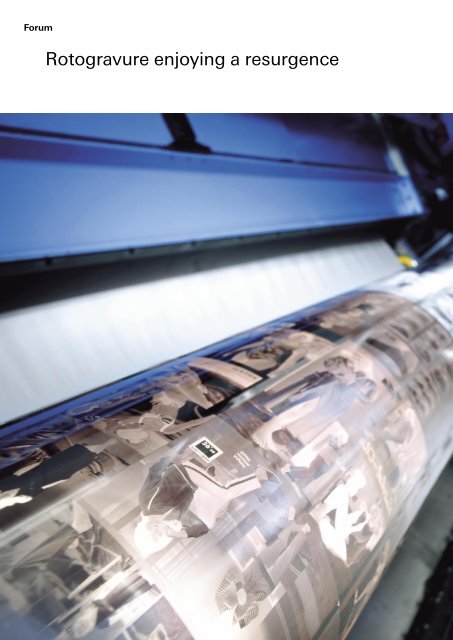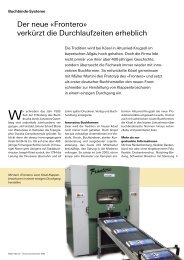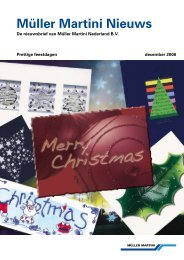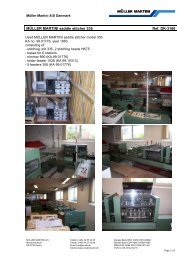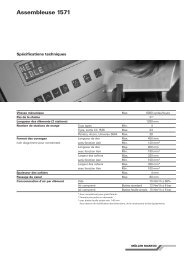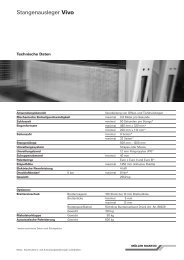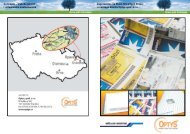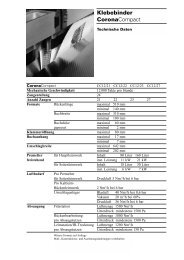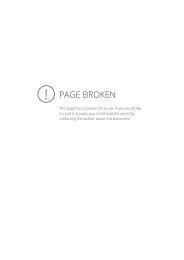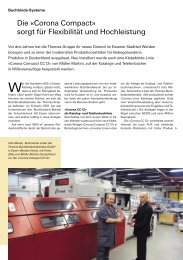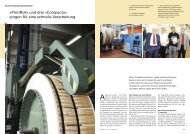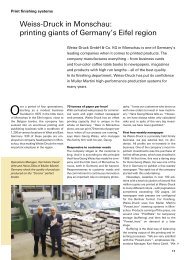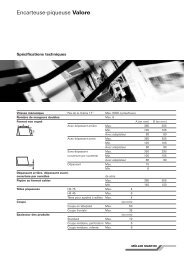Rotogravure enjoying a resurgence
Rotogravure enjoying a resurgence
Rotogravure enjoying a resurgence
Create successful ePaper yourself
Turn your PDF publications into a flip-book with our unique Google optimized e-Paper software.
Forum<br />
<strong>Rotogravure</strong> <strong>enjoying</strong> a <strong>resurgence</strong>
<strong>Rotogravure</strong> presses continue<br />
to get wider and faster.<br />
Muller Martini Panorama June 2005<br />
After several years of stagnation, rotogravure is currently<br />
experiencing a revival. As presses continue to get wider<br />
and faster, press delivery system requirements also become<br />
more demanding.<br />
For years there had been a downward<br />
trend in new investments in rotogravure<br />
– the “king of printing processes”<br />
according to James Siever, General<br />
Secretary of the European <strong>Rotogravure</strong><br />
Association (ERA). 2003 was the sector’s<br />
worst year by far – but now new equipment<br />
is being purchased again now. In<br />
Europe alone there were no fewer than 14<br />
new presses bought in 2004 and 2005.<br />
Europe has more than a 50 percent<br />
share<br />
Pira International, the industry’s monitor,<br />
is also sending out positive signals. According<br />
to the latest Pira survey, from<br />
1999 to 2004 investments in the “stronghold”<br />
of Europe fell back by another<br />
7.5 %. We say “stronghold” because ERA<br />
statistics tell us that over 50 percent of all<br />
the rotogravure presses installed in the<br />
world are running in Europe, where 20,000<br />
people are employed and every year 5.5<br />
million tons of paper are printed for magazines<br />
and catalogs.<br />
However, Pira is forecasting an increase<br />
of 1.9 percent for the period from 2004 to<br />
2009. At first glance, this figure could appear<br />
somewhat modest. But firstly it is<br />
back in the black after five years in the red.<br />
And secondly, the Pira forecasts for a few<br />
countries are already bordering on optimistic.<br />
“The British need to catch up”<br />
A growth of 26.9 percent is forecast for<br />
the United Kingdom in the next five years<br />
– compared to a decrease of 3.9 percent<br />
between 1999 and 2004. “The British have<br />
a lot of catching up to do in the rotogravure<br />
field,” says Johannes Boppel. The<br />
Project Manager responsible for rotogravure<br />
design at German press manufacturer,<br />
Koenig & Bauer AG (KBA), which<br />
incidentally is currently involved with a<br />
number of large systems in a joint venture<br />
with print finishing specialists, Muller<br />
Martini, is also happy to provide the reasons<br />
for his statement: “A significant<br />
number of rotogravure products destined<br />
for the British market is produced outside<br />
the country and must be transported<br />
across the Channel at a considerable expense.”<br />
Of course, transport costs would not be<br />
as significant if the printed products can<br />
be moved by truck. But as soon as they<br />
have to be shipped, the bill skyrockets. In<br />
addition, the time factor has an ever-increasing<br />
role to play for printed products<br />
that have come off a rotogravure press.<br />
Eastern Europe is growth market<br />
A second big growth market is Eastern<br />
Europe. “It has made a substantial contribution<br />
to the upturn in our sector of the<br />
industry,” Erik Rehmann, Marketing Man-<br />
5<br />
�
Forum<br />
ager at KBA, informs us. <strong>Rotogravure</strong> investment<br />
in the countries of Eastern Europe,<br />
where most of the complete new<br />
systems are going in, is set to rise by a<br />
sizeable 18.6 percent by the year 2009<br />
(10.7 percent between 1999 and 2004<br />
alone). The eastern European countries,<br />
where wages are low, are not only producing<br />
for export, but also in increasing quantities<br />
for their own markets, thanks to their<br />
economic boom.<br />
The first 4.32 m wide rotogravure<br />
printing press<br />
New technical developments go hand-inhand<br />
with this upward trend. Presses are<br />
getting wider and faster all the time. KBA,<br />
together with the Italian machine manufacturer<br />
Cerutti (a world leader in rotogravure<br />
illustration printing), has developed<br />
the world’s first 4.32 m (170”) wide rotogravure<br />
press for maul-belser in Nuremberg,<br />
Germany. It was put into operation<br />
at the end of 2004 at the same time as a<br />
press delivery system from Muller Martini.<br />
Three additional machines of this type will<br />
be going into service in the middle of 2006<br />
at the new printing center of arvato in<br />
Liverpool, England.<br />
With a production speed of over 15 m/s,<br />
a previously unknown level of productivity<br />
and performance in terms of area printed<br />
per hour can be achieved. Erik Rehmann<br />
proudly confirms, “the first copies coming<br />
off the new TR12B in Nuremberg have<br />
provided ample proof that the high printing<br />
quality, for which rotogravure is known<br />
is in no way suffering because of the extralarge<br />
width.”<br />
<strong>Rotogravure</strong> is the keyword<br />
<strong>Rotogravure</strong> consistently guarantees high<br />
quality with long runs like no other printing<br />
process. Gravure presses are therefore<br />
predestined for the industrial scale manufacturing<br />
of magazines, catalogs and advertising<br />
material. Their big advantage is<br />
the variable circumference of the cylinders.<br />
They allow stepless adaptation to the<br />
60,000 rph<br />
Speeds have also been increasing on par<br />
with the development of press widths.<br />
The XXL presses print at a rate of 60,000<br />
plate cylinder rotations per hour. For example:<br />
30 years ago the top speed was<br />
40,000 rotations. “Previously, I could never<br />
have imagined that 60,000 rotations an<br />
hour would be possible,” confirms Johannes<br />
Boppel. “We are hitting kinetic limits<br />
here. As a result of the acceleration, a 150<br />
gram (5 1 /3 ounces) product in the folder<br />
weighs no less than 23 kilograms (58 lbs).<br />
Therefore, because of the loading limits of<br />
the paper, the speed curve will be somewhat<br />
flatter in the future.”<br />
desired copy size with minimal trim allowance.<br />
Register-accurate paper widths of<br />
over 4.3 m (over 14 feet) can be printed<br />
problem free with 4, 6 or 8 pages on the<br />
circumference, as well as 18 pages across<br />
the width, at the highest possible processing<br />
speeds. <strong>Rotogravure</strong> printing is also<br />
one of the most environmentally-friendly<br />
With the TR12B, KBA has developed<br />
the first 4.32 m (170”) wide rotogravure<br />
press for maul-belser in Nuremberg.<br />
More favorable cylinder<br />
manufacturing costs<br />
It is true that plate cylinder manufacturing<br />
for rotogravure – especially in comparison<br />
with offset printing – has long been complicated,<br />
labor-intensive, slow and therefore<br />
expensive. Consequently, rotogravure<br />
was only used for printed products of<br />
large editions. However, the complete<br />
process automation that was previously<br />
only partially automated has, depending<br />
on cylinder quantities, enabled a drop in<br />
cylinder manufacturing costs of up to 40<br />
percent. Digitized and automated processing<br />
in the prepress section enables the fast<br />
and reliable manufacture of cylinders.<br />
printing methods, because up to 98 percent<br />
of the solvents used in the adsorption<br />
process can be recycled. “<strong>Rotogravure</strong><br />
not only has clear quality advantages, but<br />
also provides cost savings and environmental<br />
benefits,” confirms ERA General<br />
Secretary, James Siever.<br />
6 Muller Martini Panorama June 2005
4400 mm<br />
4200<br />
4000<br />
3800<br />
3600<br />
3400<br />
3200<br />
3000<br />
1988 1991 1995 1998 2001 2004<br />
Widths of rotogravure printing presses:<br />
Over a period of 16 years, the width of<br />
KBA rotogravure presses has increased<br />
from 308 to 432 cm (121 to 170”).<br />
Printed products with smaller runs can<br />
now be produced cost-effectively using a<br />
rotogravure process. The shorter setup<br />
times are, according to Johannes Bop-<br />
pel, also a good argument for produc-<br />
ing with rotogravure equipment: “In<br />
former days many printing plants did not<br />
change a single cylinder for days, but<br />
these days they are often changed on a<br />
daily basis.”<br />
New press delivery system required<br />
The fact that gravure presses were delivering<br />
higher and higher output rates naturally<br />
had a knock-on effect on the press<br />
delivery system. “Our main responsibility<br />
is the printing,” comments Johannes Boppel.<br />
“But we couldn’t just have the products<br />
produced on our presses flying onto<br />
a heap on the floor. Therefore, during the<br />
overall planning of a new installation it is<br />
important to guarantee the necessary interfaces<br />
and paper flow downstream from<br />
the press.”<br />
“The machines have to keep running,<br />
otherwise it eats into the profits,” says<br />
Felix Stirnimann, Market Sector Manager<br />
for press delivery systems at Muller Martini.<br />
One of the finishing company’s responses<br />
to ever increasing gravure press<br />
outputs is the “Maximo” high-performance<br />
log stacker.<br />
Muller Martini is an industry pioneer<br />
with a long tradition<br />
Press delivery systems have a long tradition<br />
at Muller Martini – and this does not<br />
only apply to products produced on rotogravure<br />
printing presses. An industry pioneer,<br />
the Swiss company developed the<br />
world’s first compensating stacker in 1969<br />
Muller Martini Panorama June 2005<br />
USA<br />
others<br />
Japan<br />
Europe<br />
<strong>Rotogravure</strong> printing presses around the<br />
world: With its 56 percent share, Europe<br />
is rotogravure’s stronghold.<br />
and then in 1975 the “Jumbo Stacker<br />
244”, which was the first ever fully automatic<br />
log stacker.<br />
The “Maximo” log stacker, which is the<br />
latest achievement by Muller Martini, ensures<br />
that printed products can be picked<br />
up from the press delivery smoothly, due<br />
to a cycle time of 20 seconds, a maximum<br />
page count of 128 per signature and a<br />
bundle length of 500 to 1,200 mm – even<br />
with wider, faster presses. “Muller Martini’s<br />
extensive experience with press delivery<br />
systems is reflected in the new<br />
machine,” says Felix Stirnimann, not without<br />
a certain amount of pride.<br />
Horizontal principle increases<br />
quality<br />
Just like the “AvantiPlus” (top segment)<br />
and “Vivo” (middle segment) log stackers,<br />
the “Maximo”, which was developed for<br />
the highest segment, is also based on the<br />
horizontal principle, which increases log<br />
quality and reduces waste. Apart from the<br />
high level of availability, other outstanding<br />
features of the new log stacker include<br />
product size variability (ideal for catalog<br />
producers), job data storage (ideal for<br />
publishers with repeat orders) and the interface<br />
for internal data recording (ideal<br />
for ensuring continuous workflow according<br />
to JDF/JMF).<br />
The “Maximo” is controlled by a master<br />
control system that has also been newly<br />
developed (Macos). This control system<br />
allows a better overall view of the system<br />
and the process sequence. It also ensures<br />
a more accurate display, so that faults can<br />
be rectified quickly. “Because every holdup,<br />
even short ones, increases the waste<br />
rate,” Felix Stirnimann points out.<br />
rph<br />
60 000<br />
50 000<br />
40 000<br />
30 000<br />
20 000<br />
10 000<br />
0<br />
1955 1965 1975 1985 1995 2000<br />
Speed of rotogravure presses: In future,<br />
the speed curve will have a flatter profile<br />
because of the loading limits of the paper<br />
stock.<br />
Log, rolls, bundles, pallets . . .<br />
Including log stackers, Muller Martini has<br />
another couple of strings to its bow in the<br />
press delivery area in regards to roll systems<br />
and bundle-building. “Bundle building<br />
is the most efficient method of shortterm<br />
storage and finishing for products<br />
with medium to longer processing times,”<br />
Mr. Stirnimann informs us. “For example,<br />
it is ideally suited for telephone books.”<br />
However, roll systems have the highest<br />
level of automation. They are especially<br />
useful for publications with short processing<br />
times. Only one person is required to<br />
operate the press delivery system and<br />
load the saddle stitcher or perfect binder.<br />
Building bundles (often from finished<br />
products) and subsequent palletizing is<br />
also highly automated. Loading the bundles<br />
requires the most manpower. “This<br />
method of finishing,” says Felix Stirnimann,<br />
“enables the greatest possible flexibility.”<br />
. . . and rotary trimmers<br />
Beside buffer systems, rotary trimmers<br />
are also responsible for the efficient finishing<br />
of printed products. They can be used<br />
both inline and offline. In the case of rotogravure<br />
and high-volume offset printed<br />
products, however, they are detached<br />
from the press – as in businesses with a<br />
small proportion of finished products.<br />
Therefore, finishing is best not coupled<br />
with the press.<br />
www.mullermartini.com<br />
www.kba-print.de<br />
www.cerutti.it<br />
www.era.eu.org<br />
www.pira.co.uk<br />
7<br />
�
Forum<br />
Press delivery systems from Muller Martini<br />
“Maximo” log stacker<br />
� Cycle time:<br />
20 seconds/log<br />
� Maximum number of pages:<br />
128/signature<br />
� Log length:<br />
500–1,200 cm<br />
“AvantiPlus” log stacker<br />
� Cycle time:<br />
32 seconds/log<br />
� Maximum number of pages:<br />
96/signature<br />
� Log length:<br />
500–1,200 cm<br />
“Vivo” log stacker<br />
� Cycle time:<br />
60 seconds/log<br />
� Maximum number of pages:<br />
32/signature<br />
� Log length:<br />
500–1,200 cm<br />
“Forte” compensating stacker<br />
� Cycle time:<br />
1.2 meters/second<br />
� Mechanical output:<br />
100,000 copies/hour<br />
� Maximum stack height:<br />
350 mm<br />
“Cohiba” automatic palletizer<br />
� Bundles per minute:<br />
max. 24 (packaged A4)<br />
� Pallet height:<br />
max. 1,600 mm<br />
� Product size:<br />
A5–A3<br />
8<br />
“Fontana” automatic palletizer<br />
� Bundles per minute:<br />
max. 40 (packaged A4)<br />
� Pallet height:<br />
max. 1,600 mm<br />
� Product size:<br />
A6–A3<br />
“PrintRoll Universal” roll system<br />
� Folded signature with overlap:<br />
min. 200 x 145 mm,<br />
max. 480 x 320 mm<br />
� Number of pages:<br />
min. 4 (90 g/m 2 )<br />
or 16 (45 g/m 2 ), max. 96<br />
� Number of straps: 2<br />
“PrintRoll P220” roll system<br />
� Folded signature with overlap:<br />
min. 200 x 145 mm,<br />
max.. 340 x 260 mm<br />
� Number of pages:<br />
min. 4 (90 g/m 2 )<br />
or 16 (45 g/m 2 ), max. 96<br />
� Number of straps: 1<br />
“Compacto” rotary trimmer<br />
� Transport speed:<br />
max. 60 meters/minute<br />
� Trim thickness, compressed:<br />
max. 8 mm<br />
� Signature size: untrimmed<br />
max. 550 � 500 mm,<br />
trimmed max. 544 � 497 mm<br />
“Exacto” rotary trimmer<br />
� Transport speed:<br />
max. 60 meters/minute<br />
� Trim thickness, compressed:<br />
max. 12 mm<br />
� Product size:<br />
untrimmed max. 490 � 490 mm,<br />
trimmed max. 484 � 487 mm<br />
Muller Martini Panorama June 2005


